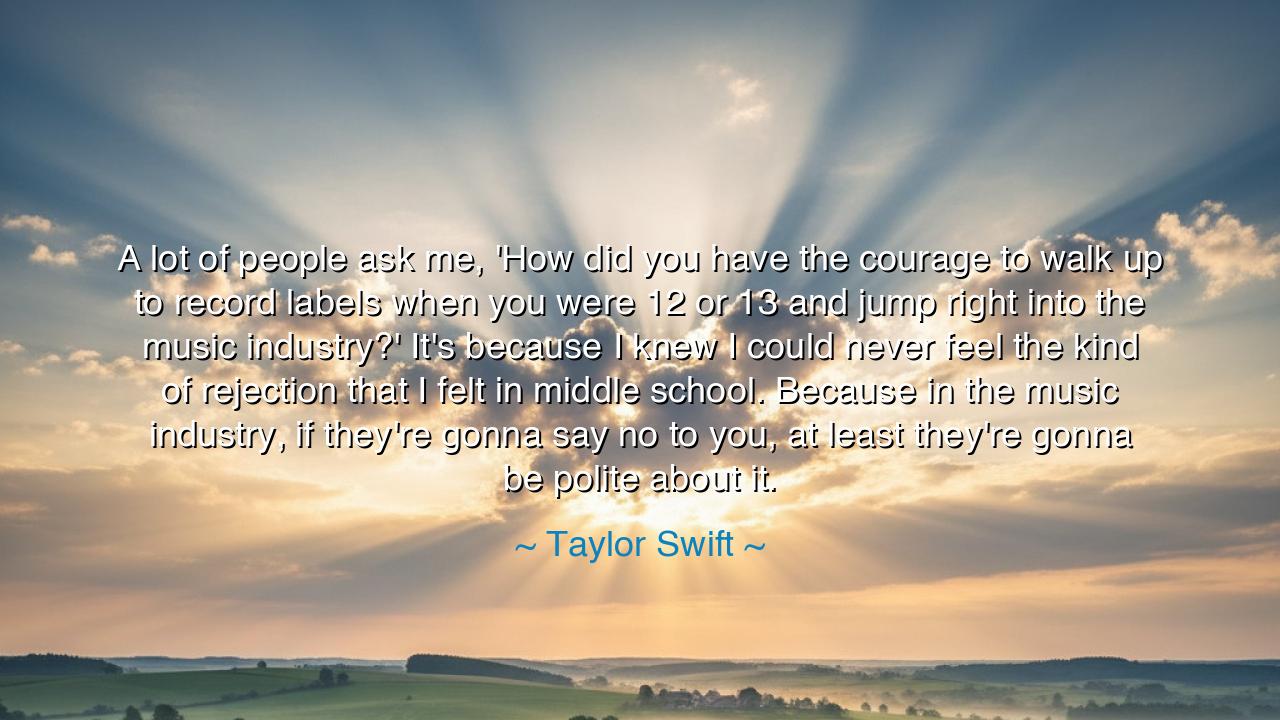
A lot of people ask me, 'How did you have the courage to walk up
A lot of people ask me, 'How did you have the courage to walk up to record labels when you were 12 or 13 and jump right into the music industry?' It's because I knew I could never feel the kind of rejection that I felt in middle school. Because in the music industry, if they're gonna say no to you, at least they're gonna be polite about it.






“A lot of people ask me, ‘How did you have the courage to walk up to record labels when you were 12 or 13 and jump right into the music industry?’ It’s because I knew I could never feel the kind of rejection that I felt in middle school. Because in the music industry, if they’re gonna say no to you, at least they’re gonna be polite about it.” Thus spoke Taylor Swift, the poet of her generation, whose art and ambition were born from pain as much as from talent. In these words, she reveals a truth as old as the human spirit—that courage often grows from the ashes of rejection, and that the wounds of youth can become the armor of destiny. Her confession is not one of bitterness but of transformation; she teaches that the sting of rejection, once endured, can free the soul from fear forever.
The origin of this quote lies in Swift’s own early journey—a girl of twelve, armed with a guitar and unshakable determination, walking into record labels in Nashville with dreams that most would have deemed impossible. Yet what fueled her was not arrogance, but resilience. The rejection she had faced in her middle school years, the loneliness and ridicule of youth, had already carved her heart into something unbreakable. She had met cruelty unmasked, and so the professional refusals of the music world seemed gentle by comparison. Her courage, therefore, was not born from confidence—it was born from experience.
There is a deep and timeless wisdom in this: that pain, when faced with dignity, can become the foundation of power. The ancients spoke of this transformation as the tempering of the soul, as iron is forged in fire. The one who has known rejection and yet stands again is no longer bound by fear. Swift’s story is an echo of that eternal truth: that the child who once suffered exclusion became the artist who turned pain into melody, sorrow into song. In her words, we hear the alchemy of adversity—how life’s hardest lessons become life’s strongest weapons.
Consider the tale of Abraham Lincoln, who faced failure in business, defeat in elections, and loss in his personal life, yet rose to become one of history’s greatest leaders. Each rejection refined his humility and deepened his resolve. Like Swift, he understood that rejection is not the end, but the beginning of resilience. Lincoln once said that he was not concerned that the Lord was on his side, but that he might be on the Lord’s. Such humility before hardship is the mark of greatness—it is the soul’s refusal to let suffering harden it into despair.
Taylor Swift’s reflection also reminds us that the cruelty of youth can leave scars that last—but those scars can also become symbols of endurance. The mockery she endured in middle school became the measure of all later trials. Having already faced the worst—the unkindness of peers, the loneliness of difference—she found no terror in the polite refusals of executives. Her story stands as a parable: once you have endured the raw and unfiltered cruelty of the world, the structured rejections of life lose their sting. You realize that what cannot destroy you can only define you.
The lesson, then, is profound: pain can either imprison or empower, depending on how one meets it. When life rejects you, do not retreat—transform. Let your suffering become your strength, your heartbreak your harvest. The world will not always applaud you, nor even treat you kindly, but you alone decide what meaning to make of your trials. Swift teaches that courage does not come from the absence of fear, but from familiarity with pain. The one who has faced darkness and learned its language no longer trembles before it.
To live by this wisdom, one must not seek to avoid rejection, but to understand it. When you are told “no,” listen instead for the challenge hidden within it. Ask yourself not, “Why me?” but “What can I learn?” Let rejection be your teacher, and it will become your foundation. For every “no” brings you closer to the truth of who you are meant to be. And as Swift’s journey shows, when you rise above the world’s cruelty, even polite rejection becomes powerless before your courage.
So remember, dear listener: the deepest wounds of youth may yet become your greatest strengths. Do not despise the rejections that have shaped you—they are your training ground, the silent architects of your resilience. If you would walk into the halls of destiny as Taylor Swift did, do not wait for fear to vanish. Walk with it. Walk through it. And when you emerge, you will discover that courage is not the absence of pain—it is the triumph of purpose over it. For the soul that endures rejection with grace has already won the victory the world cannot take away.






AAdministratorAdministrator
Welcome, honored guests. Please leave a comment, we will respond soon